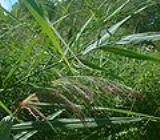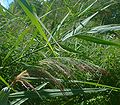
Reed bed
Encyclopedia


Floodplain
A floodplain, or flood plain, is a flat or nearly flat land adjacent a stream or river that stretches from the banks of its channel to the base of the enclosing valley walls and experiences flooding during periods of high discharge...
s, waterlogged depressions and
estuaries
Estuary
An estuary is a partly enclosed coastal body of water with one or more rivers or streams flowing into it, and with a free connection to the open sea....
. Reed beds are part of a succession
Ecological succession
Ecological succession, is the phenomenon or process by which a community progressively transforms itself until a stable community is formed. It is a fundamental concept in ecology, and refers to more or less predictable and orderly changes in the composition or structure of an ecological community...
from young reed colonising open water or wet ground through a gradation of increasingly dry ground. As reed beds age, they build up a considerable litter layer which eventually rises above the water level, and ultimately provides opportunities for scrub or woodland invasion. Artificial reed beds are used as a method of removing pollutants from grey water.
Types of reed bed
Reed beds vary in the species they can support, depending on water levels within the wetland system, climate, seasonal variations, and the nutrient status and salinity of the water. Those that normally have 20 cm or more of surface water during the summer are referred to as reed swamp. These often have high invertebrate and bird species use. Reed beds with water levels at or below the surface during the summer are often more complex botanically and are known as reed fen. Reeds and similar plants do not generally grow in very acidic water, and so in these situations reed beds are replaced by other vegetation such as poor-fen and bogBog
A bog, quagmire or mire is a wetland that accumulates acidic peat, a deposit of dead plant material—often mosses or, in Arctic climates, lichens....
.
Although common reed is characteristic of reed beds, not all vegetation dominated by this species is reed bed. It also occurs commonly in unmanaged damp grassland
Grassland
Grasslands are areas where the vegetation is dominated by grasses and other herbaceous plants . However, sedge and rush families can also be found. Grasslands occur naturally on all continents except Antarctica...
and as an understorey in certain types of damp woodland
Woodland
Ecologically, a woodland is a low-density forest forming open habitats with plenty of sunlight and limited shade. Woodlands may support an understory of shrubs and herbaceous plants including grasses. Woodland may form a transition to shrubland under drier conditions or during early stages of...
.
Wildlife
Most European reed beds are composed mainly of the large wetland grass common reed (Phragmites australis), but also include many other tall monocotyledons adapted to growing in wet conditions – other grasses such as reed sweet-grass (Glyceria maximaGlyceria maxima
Glyceria maxima Holmb. is a species of rhizomatous perennial grasses in the mannagrass genus native to Europe and Western Siberia and growing in wet areas such as riverbanks and ponds...
), Canary reed-grass (Phalaris arundinacea) and small-reed (Calamagrostis
Calamagrostis
Calamagrostis, or Small-reed or Reedgrass, is a genus in the Grass family Poaceae with about 260 species that occur mainly in temperate regions of the Northern Hemisphere and the southern hemisphere. Towards equatorial latitudes, species of Calamagrostis generally occur at higher elevations in...
species
Species
In biology, a species is one of the basic units of biological classification and a taxonomic rank. A species is often defined as a group of organisms capable of interbreeding and producing fertile offspring. While in many cases this definition is adequate, more precise or differing measures are...
), large sedges (species of Carex
Carex
Carex is a genus of plants in the family Cyperaceae, commonly known as sedges. Other members of the Cyperaceae family are also called sedges, however those of genus Carex may be called "true" sedges, and it is the most species-rich genus in the family. The study of Carex is known as...
, Scirpus
Scirpus
The plant genus Scirpus consists of a large number of aquatic, grass-like species in the family Cyperaceae , many with the common names club-rush or bulrush . Other common names are deergrass or grassweed.The genus has a cosmopolitan distribution, and grows in wetlands and moist soil...
, Schoenoplectus
Schoenoplectus
Schoenoplectus is a genus of about 80 species of sedges with a cosmopolitan distribution. Note that the name bulrush is also applied to species in the unrelated genus Typha...
, Cladium
Cladium
Cladium is a genus of large sedges, with a worldwide distribution in tropical and temperate regions...
and related genera
Genus
In biology, a genus is a low-level taxonomic rank used in the biological classification of living and fossil organisms, which is an example of definition by genus and differentia...
), yellow flag iris (Iris pseudacorus
Iris pseudacorus
Iris pseudacorus is a species of Iris, native to Europe, western Asia and northwest Africa. Common names include yellow iris and yellow flag...
), reed-mace ("bulrush" – Typha
Typha
Typha is a genus of about eleven species of monocotyledonous flowering plants in the family Typhaceae. The genus has a largely Northern Hemisphere distribution, but is essentially cosmopolitan, being found in a variety of wetland habitats...
species), water-plantains (Alisma
Alisma
Alisma is a genus of flowering plants in the family Alismataceae, members of which are commonly known as water-plantains. The genus consists of aquatic plants with leaves either floating or submerged, found in a variety of still water habitats around the world . The flowers are hermaphrodite, and...
species), and flowering rush (Butomus umbellatus). Many dicotyledon
Dicotyledon
The dicotyledons, also known as dicots, are a group of flowering plants whose seed typically has two embryonic leaves or cotyledons. There are around 199,350 species within this group...
s also occur, such as water mint (Mentha aquatica), gipsywort (Lycopus europaeus), skull-cap (Scutellaria
Scutellaria
Scutellaria is a genus of flowering plants in the mint family, Lamiaceae. It contains about 300 species, which are commonly known as skullcaps...
species), touch-me-not balsam (Impatiens noli-tangere), brooklime (Veronica beccabunga) and water forget-me-nots (Myosotis species).
Many animals are adapted to living in and around reed-beds. These include mammals such as Eurasian otter, European beaver
European Beaver
The Eurasian beaver or European beaver is a species of beaver, which was once widespread in Eurasia, where it was hunted to near extinction both for fur and for castoreum, a secretion of its scent gland believed to have medicinal properties...
, water vole
Arvicola
The water voles are large voles in the genus Arvicola. They are found in both aquatic and dry habitat through Europe and much of northern Asia...
, Eurasian harvest mouse and water shrew
Neomys
The genus Neomys is a group of three Eurasian water shrews from the subfamily Soricinae of the family Soricidae. These shrews are found in most of Europe, and parts of Northern Asia as well as Turkey and Iran...
, and birds such as Great Bittern
Great Bittern
The Eurasian Bittern or Great Bittern is a wading bird of the heron family Ardeidae. It is one of the species to which the Agreement on the Conservation of African-Eurasian Migratory Waterbirds applies.-Etymology:...
, Purple Heron
Purple Heron
The Purple Heron is a wading bird in the heron family Ardeidae, breeding in Africa, central and southern Europe, and southern and eastern Asia. The European populations are migratory, wintering in tropical Africa; the more northerly Asian populations also migrate further south within Asia...
, European Spoonbill, Water Rail
Water Rail
The Water Rail is a bird of the rail family which breeds in well-vegetated wetlands across Europe, Asia and North Africa. Northern and eastern populations are migratory, but this species is a permanent resident in the warmer parts of its breeding range...
(and other rail
Rallidae
The rails, or Rallidae, are a large cosmopolitan family of small to medium-sized birds. The family exhibits considerable diversity and the family also includes the crakes, coots, and gallinules...
s), Purple Gallinule
Purple Swamphen
The Purple Swamphen , also known as the African Purple Swamphen, Purple Moorhen, Purple Gallinule, Pūkeko or Purple Coot, is a large bird in the family Rallidae . From its name in French, talève sultane, it is also known as the Sultana Bird...
, Marsh Harrier
Marsh harrier
The marsh harriers are birds of prey of the harrier subfamily. They are medium-sized raptors and the largest and broadest-winged harriers. Most of them are associated with marshland and dense reedbeds...
, various warbler
Old World warbler
The "Old World Warblers" is the name used to describe a large group of birds formerly grouped together in the bird family Sylviidae. The family held over 400 species in over 70 genera, and were the source of much taxonomic confusion. Two families were split out initially, the cisticolas into...
s (Reed Warbler
Reed Warbler
The Eurasian Reed Warbler, or just Reed Warbler, Acrocephalus scirpaceus, is an Old World warbler in the genus Acrocephalus. It breeds across Europe into temperate western Asia. It is migratory, wintering in sub-Saharan Africa....
, Sedge Warbler
Sedge Warbler
The Sedge Warbler is an Old World warbler in the genus Acrocephalus. It is a medium-sized warbler with a brown, streaked back and wings and a distinct pale supercilium. Sedge Warblers are migratory, crossing the Sahara to get from their European and Asian breeding grounds to spend winter in Africa...
etc), Bearded Reedling and Reed Bunting
Reed Bunting
The Reed Bunting, Emberiza schoeniclus, is a passerine bird in the bunting family Emberizidae, a group now separated by most modern authors from the finches, Fringillidae....
.

Constructed wetlands
Constructed wetlands are artificial swamps (sometimes called reed fields) using reed or other marshland plants to form part of small-scale sewageSewage
Sewage is water-carried waste, in solution or suspension, that is intended to be removed from a community. Also known as wastewater, it is more than 99% water and is characterized by volume or rate of flow, physical condition, chemical constituents and the bacteriological organisms that it contains...
treatment systems. Water
Water
Water is a chemical substance with the chemical formula H2O. A water molecule contains one oxygen and two hydrogen atoms connected by covalent bonds. Water is a liquid at ambient conditions, but it often co-exists on Earth with its solid state, ice, and gaseous state . Water also exists in a...
trickling through the reed bed is cleaned by microorganism
Microorganism
A microorganism or microbe is a microscopic organism that comprises either a single cell , cell clusters, or no cell at all...
s living on the root system and in the litter. These utilising the sewage for growth nutrient
Nutrient
A nutrient is a chemical that an organism needs to live and grow or a substance used in an organism's metabolism which must be taken in from its environment. They are used to build and repair tissues, regulate body processes and are converted to and used as energy...
s, resulting in a clean effluent
Effluent
Effluent is an outflowing of water or gas from a natural body of water, or from a human-made structure.Effluent is defined by the United States Environmental Protection Agency as “wastewater - treated or untreated - that flows out of a treatment plant, sewer, or industrial outfall. Generally refers...
. The process is very similar to aerobic conventional sewage treatment, as the same organisms are used, except that conventional treatment systems require artificial aeration.
Treatment ponds

Treatment ponds are small versions of constructed wetlands which uses reed beds or other marshland plants to form an even smaller water treatment system. Similar to constructed wetlands, water trickling through the reed bed is cleaned by microorganism
Microorganism
A microorganism or microbe is a microscopic organism that comprises either a single cell , cell clusters, or no cell at all...
s living on the root system and in the litter. Treatment ponds are used for the water treatment of a single house or a small neighbourhood.

